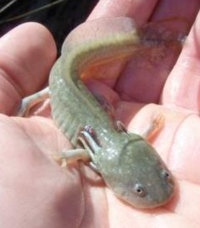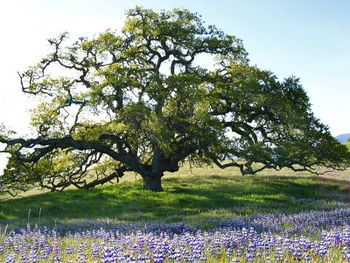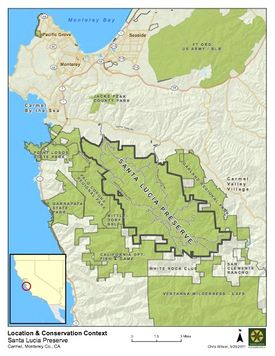Santa Lucia Conservancy
Santa Lucia Conservancy (SLC) is an independent, non-profit land trust charged with stewardship of Santa Lucia Preserve, 2,000 acres of privately-owned land and 18,000 acres of conserved land located in the Carmel Watershed along California's central coast.[1] As a private, independent organization, Santa Lucia Conservancy is a non-government entity. However, as a 502(c)(3) non-profit, Santa Lucia Conservancy is tax-exempt under the US Internal Revenue Code.[2] SLC operations are overseen by a board of governors whose members comprise landowners, scientists, and conservationists.[3] Only ten percent of the preserve is designated for development of residences, ranches, and community structures, while the remaining ninety percent is designated as permanently undeveloped.[4] Santa Lucia Preserve currently has 300 homesites, with for-sale homes in the $4-14 million range.[3]
Contents
Objectives
The approach Santa Lucia Conservancy has taken to protect lands in Santa Lucia Preserve centers around land management, ecological research, easement stewardship, and environmental education.[5]
Land management: SLC manages 10,350 acres of wildlands in Santa Lucia Preserve, while the remaining acreage is privately owned. All 18,000 preserved acres are managed by collaborations between SLC and private landowners. SLC land management activities include:[5]
- mowing & pruning of foliage
- prescribed fires
- application of herbicide
- controlled ungulate grazing
- environmental monitoring
Ecological research: SLC supports on-site ecological research through private studies, collaboration with researchers, and mentorship of interns.[5]
Easement stewardship: SLC is obliged to enforce compliance with rules set in place for conservation easements (use of conserved land for specified purposes).[5]
Environmental education: SLC promotes education through engagement programs with local students and community members about environmental awareness and the importance of land conservation.[5]
History
- early 1800s: Mexican land grants establish El Potrero de San Carlos and San Francisquito, the precursors of Rancho San Carlos, now an appreciable portion of Santa Lucia Preserve[6]
- 1857: El Potrero de San Carlos and San Francisquito are combined to form Rancho San Carlos, a fully-functioning cattle ranch[6]
- 1906: City of Carmel is founded[7]
- 1924: Rancho San Carlos is converted to a "gentleman's ranch", including construction of a villa and polo field[6]
- 1939: Rancho San Carlos changes ownership again, returning to its previous land use of cattle ranching[6]
- 1990: The founders of Santa Lucia Preserve acquire Rancho San Carlos and begin development and conservation planning[6]
- 1994: Santa Lucia Conservancy is established[8]
Projects & science
Internal
Wildlife monitoring: SLC is required to monitor the wildlife found on lands it protects. Efforts consist of bird and nest counts, locating threatened species such as the CA red-legged frog, detection of invasive plants and weeds, and assessment of overall grassland health.[9]
Conservation grazing: SLC is actively engaged in conservation grazing, or the use of ungulates to control unwanted species and promote native plant growth. For example, in 2015 SLC mobilized 1,400 goats to cut back overgrown grasslands that had historically been exposed to grazing by native ungulates and domestic cattle. In response, threatened California Tiger Salamander numbers increased.[10]
Plant restoration: SLC participates in native plant restoration efforts, including native seed collection.[11] Other contributions are associated with invasive weed removal via mowing and grazing.
External
Hydrologic baseflow conditions: Four major streams flow through Santa Lucia Preserve, Lower Las Garzas, Portero, San Jose, and San Clemente Creek, all of which provide habitat for threatened species. To satisfy monitoring requirements set by the California Environmental Quality Act (CEQA), SLC routinely outsources river monitoring tasks to The Watershed Institute at California State University Monterey Bay (CSUMB).[8]
Graduate-level research projects: SLC has mentored and/or provided internships for several CSUMB graduate students, for which it has been the recipient of federal funding. Resultant research projects have focused on surface flow of the Carmel River[12] as well as conservation grazing and avian nest boxes. [11]
Resources at stake

Groundwater
The majority of Monterey Peninsula's potable water comes from the Carmel Valley Alluvial Aquifer, which is overlain in large part by Santa Lucia Preserve. Consequently, land use and other human influences in the Santa Lucia Preserve can play significant roles in water quality and quantity in the region.[13]
Threatened species habitat
Santa Lucia Conservancy is in charge of land that is home to several threatened species; it is therefore subject to CEQA regulations. Threatened species present on Santa Lucia Preserve are:[10]
- Steelhead trout
- CA red-legged frog
- California Tiger Salamander
Affiliations & stakeholders
- Monterey Peninsula Water Management District (MPWMD)
- California American Water Company (CalAm)
- Monterey County Water Resources Agency
- Carmel Area Wastewater District (CAWD)
- Carmel River Steelhead Association (CRSA)
- Carmel River Watershed Conservancy (CRWC)
- City of Carmel
- The Watershed Institute at CSUMB
- Resource Conservation District of Monterey County
- Planning & Conservation League Foundation
- Ventana Wildlife Society
- California State Parks
Links
- Land Trusts and Conservancies in California's Central Coast Region
- The Nature Conservancy (TNC)
- Carmel Watershed
- Carmel Watershed Issues
- Maps of the Carmel River Watershed
- Conservation Easement
References
- ↑ Santa Lucia Conservancy Website - About [1]
- ↑ 501(c)(3) Non-Profit Organizations [2]
- ↑ 3.0 3.1 Santa Lucia Conservancy Fact Sheet [3]
- ↑ Santa Lucia Conservancy Website - Real Estate [4]
- ↑ 5.0 5.1 5.2 5.3 5.4 Santa Lucia Conservancy Brochure [5]
- ↑ 6.0 6.1 6.2 6.3 6.4 Santa Lucia Conservancy Website - Our Story [6]
- ↑ Santa Lucia Conservancy Website - Real Estate[7]
- ↑ 8.0 8.1 Hydrologic Conditions in Baseflow Reaches Pursuant to Conditions [8]
- ↑ Santa Lucia Website - Conservation Projects [9]
- ↑ 10.0 10.1 Monterey County Herald [10]
- ↑ 11.0 11.1 Land Management of the Santa Lucia Conservancy [11]
- ↑ CSUMB Professional Science Master's project list [12]
- ↑ Carmel Valley Groundwater Basin [13]
Disclaimer
This page may contain student work completed as part of assigned coursework. It may not be accurate. It does not necessary reflect the opinion or policy of CSUMB, its staff, or students.


